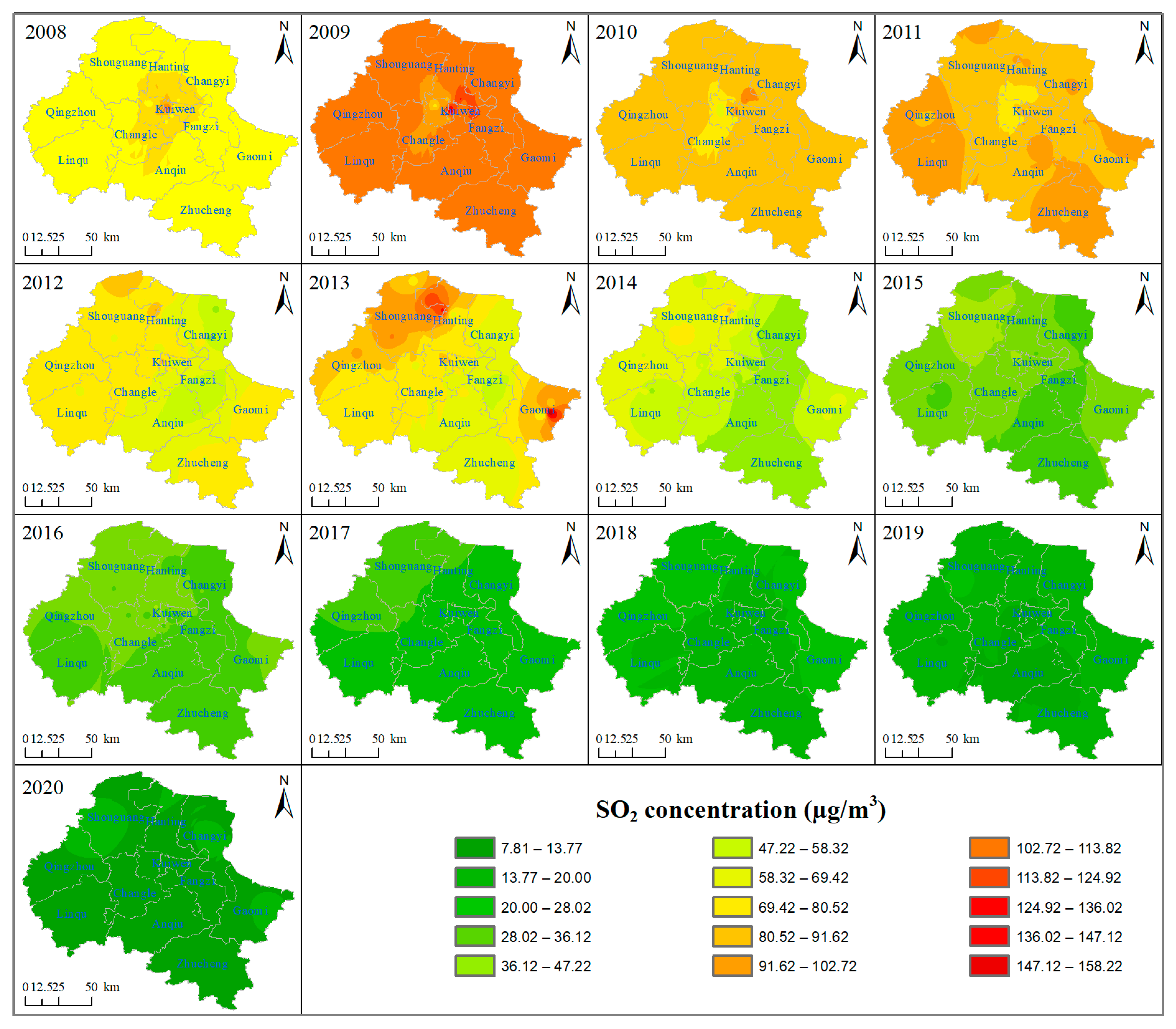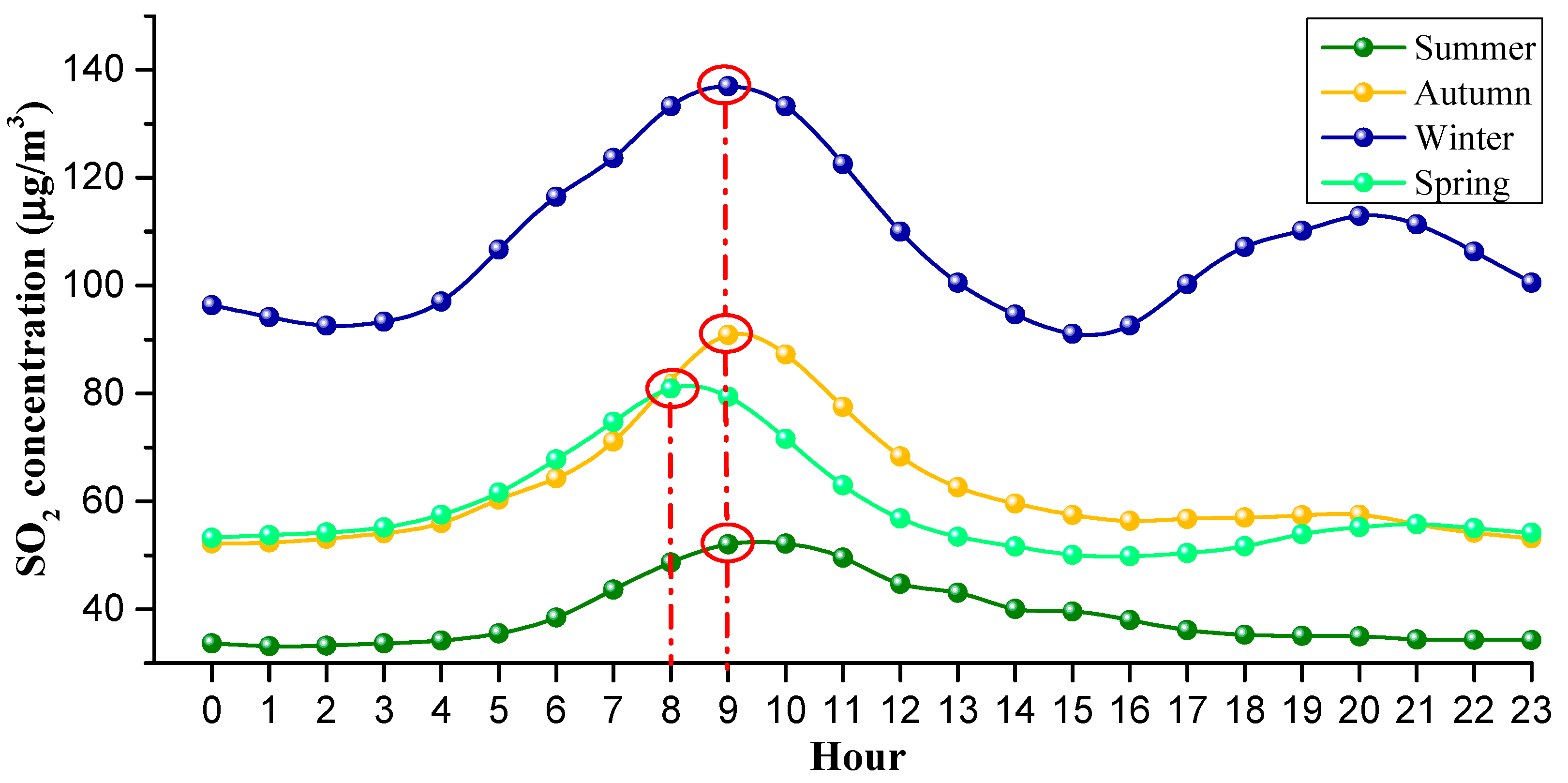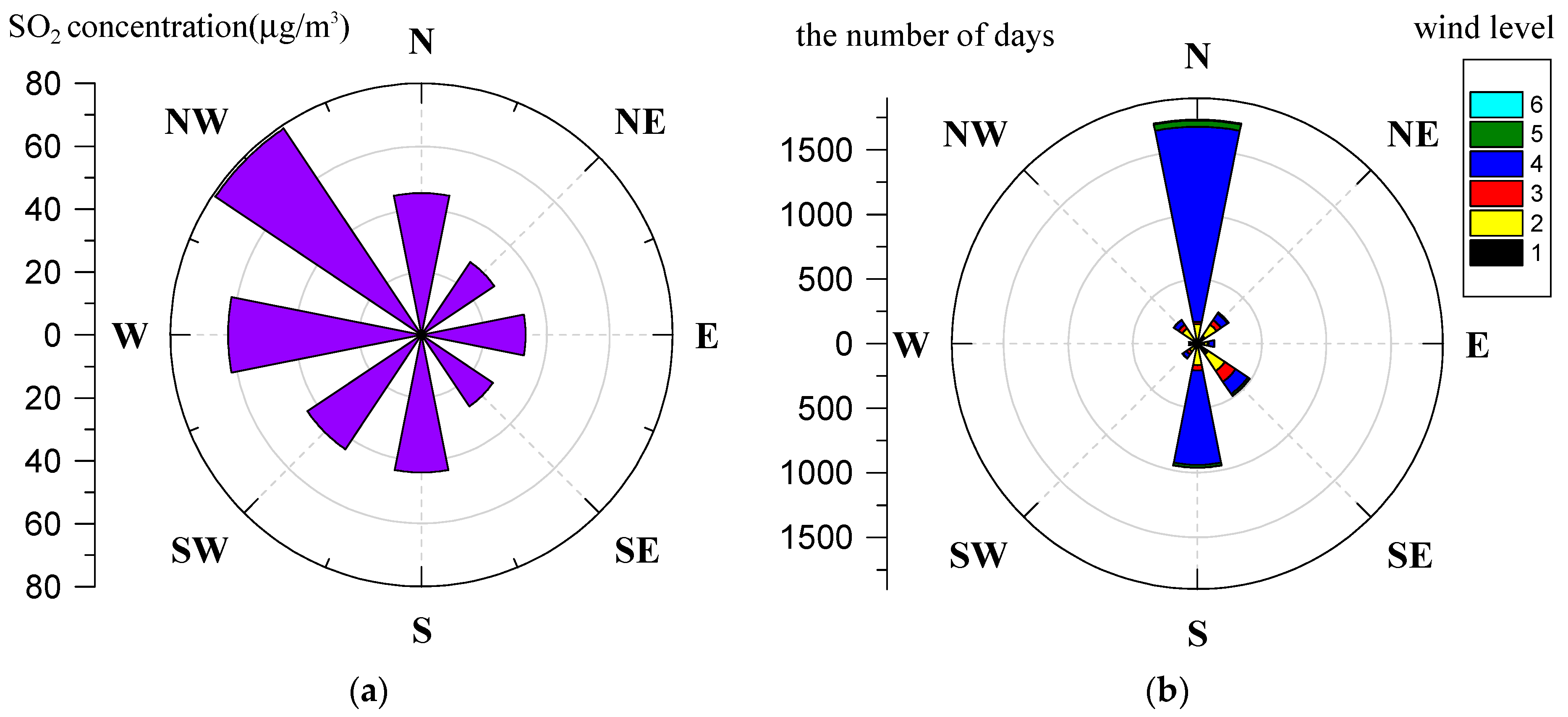Spatio-Temporal Characteristics of SO2 across Weifang from 2008 to 2020
Abstract
:1. Introduction
2. Materials and Methods
2.1. Study Area
2.2. Data Source
2.3. Methodology
2.3.1. Kriging Interpolation Model
2.3.2. The SO2 Center of Gravity Migration Model
2.3.3. The Regression Model
3. Results and Discussion
3.1. SO2 Spatio-Temporal Characteristics
3.1.1. Annual Spatio-Temporal Changes of SO2
3.1.2. Seasonal and Monthly Spatio-Temporal Changes in SO2
3.1.3. Weekly Spatio-Temporal Changes in SO2
3.1.4. Hourly Changes in SO2
3.2. The SO2 Center of Gravity Migration Trajectory
3.3. The Correlation Analysis between SO2 and Wind
4. Conclusions
- (1)
- The average concentration of SO2 showed a decreasing trend from 2008 (92.7 ± 50.9 µg/m3) to 2020 (10.4 ± 6.5 µg/m3). Before 2014, the SO2 concentration showed a fluctuating downward trend, and exceeded the CAAQS Grade II standard (60 µg/m3). Since 2014, the SO2 concentration has been continuously decreasing. In 2018, SO2 concentration was lower than the CAAQS Grade I standard (20 µg/m3). This contributed to the strict measures taken by the Chinese government, and the environmental protective actions implemented by the Weifang city government, such as elimination of polluting vehicles, elimination of small coal-fired boilers, installation of exhaust gas monitoring equipment, delineation of no-burning zones and so on.
- (2)
- The spatial pattern of SO2 pollution shows that the SO2 concentration presented obvious spatial heterogeneity. Specifically, the SO2 concentration was higher in the north than in the south, and higher in the west than in the east. In 2008, the SO2 concentration in central city was significantly higher than that in surrounding areas. Since 2009, the SO2 pollution shifted from the urban center to the outside. By 2013, two heavily polluted areas (Hanting and Gaomi) were formed in the marginal area. At present, Shouguang, Changyi and Gaomi have the most serious SO2 pollution. We recommend optimizing the industrial structure of these three regions to control the SO2 pollution.
- (3)
- On the seasonal scale, the SO2 concentration was winter > autumn > spring > summer. In the winter of 2020, the daily average concentration of SO2 in the northern part of Weifang was still exceeding 20 µg/m3, while the World Health Organization recommends that the daily average concentration of SO2 should not exceed 20 µg/m3. The reason for this phenomenon was the weather conditions in winter and coal-fired heating. It is recommended that relevant departments in Weifang take measures to reduce the SO2 concentration in the northern region in winter, such as central heating, natural gas heating and polluting enterprises to temporarily suspend production.
- (4)
- On the daily scale, the SO2 concentration on the weekend was higher than that on weekdays, and the SO2 concentration was highest on Saturday. On the weekend, the SO2 concentration in Weicheng district, the central district of Weifang, increased significantly. The daily-scale variation characteristics of SO2 concentration are closely related to human travel and work. It is recommended that Weifang citizens travel greener and more staggered on the weekend.
- (5)
- On the hourly scale, the peak in the SO2 concentration was around 9 a.m. and the valley was around 4 p.m. The peak value varied with the seasons. In detail, the peak in spring occurred at 8 a.m., while the peak in other seasons occurred around 9 a.m. This phenomenon shows that hourly scale changes are closely related to residents’ commuting activities. In Weifang city, it is possible to implement staggered commuting and promote new energy vehicles. In addition, we can also vigorously develop public transportation to avoid excessive SO2 concentration in the short term, which threatens people’s health.
- (6)
- The SO2 center of gravity migrated to the northeast as a whole. This shows that the SO2 pollution in the northeast of Weifang is more serious than other areas, especially from 2017 to 2018. This result may be related to the construction of the Binhai Economic Development Zone located in the northeast coastal area. We can reduce the SO2 pollution in these areas by optimizing the industrial model of the Binhai Economic Development Zone.
- (7)
- From the correlation analysis between SO2 and wind, the order of the SO2 concentration from high to low is as follows: northwest wind > west wind > north wind > south wind > southwest wind > east wind > northeast wind > southeast wind. The clean wind direction (southeast wind, northeast wind) accounted for about 19%, while the polluted wind direction (northwest wind, west wind) accounted for about 7%.
Author Contributions
Funding
Data Availability Statement
Conflicts of Interest
References
- Guo, H.; Wei, J.; Li, X.; Ho, H.C.; Song, Y.; Wu, J.; Li, W. Do socioeconomic factors modify the effects of PM1 and SO2 on lung cancer incidence in China? Sci. Total Environ. 2021, 756, 143998. [Google Scholar] [CrossRef] [PubMed]
- Jiang, L.; Zhou, H.; He, S. The role of governments in mitigating SO2 pollution in China: A perspective of fiscal expenditure. Environ. Sci. Pollut. Res. 2020, 27, 33951–33964. [Google Scholar] [CrossRef]
- Dedoussi, I.C.; Eastham, S.D.; Monier, E.; Barrett, S.R.H. Premature mortality related to United States cross-state air pollution. Nature 2020, 578, 261–265. [Google Scholar] [CrossRef]
- Hu, M.; Wang, Y.; Wang, S.; Jiao, M.; Huang, G.; Xia, B. Spatial-temporal heterogeneity of air pollution and its relationship with meteorological factors in the Pearl River Delta, China. Atmos. Environ. 2021, 254, 118415. [Google Scholar] [CrossRef]
- Khan, M.A.H.; Rao, M.V.; Li, Q. Recent Advances in Electrochemical Sensors for Detecting Toxic Gases: NO2, SO2 and H2S. Sensors 2019, 19, 905. [Google Scholar] [CrossRef] [PubMed] [Green Version]
- Sram, R.J. Impact of Air Pollution on the Health of the Population in Parts of the Czech Republic. Int. J. Environ. Res. Public Health 2020, 17, 6454. [Google Scholar] [CrossRef] [PubMed]
- Carlsen, H.K.; Valdimarsdóttir, U.; Briem, H.; Dominici, F.; Finnbjornsdottir, R.G.; Jóhannsson, T.; Aspelund, T.; Gislason, T.; Gudnason, T. Severe volcanic SO2 exposure and respiratory morbidity in the Icelandic population-a register study. Environ. Health 2021, 20, 23. [Google Scholar] [CrossRef]
- Guo, Z.; Chen, S.S.; Yao, S.; Mkumbo, A.C. Does foreign direct investment affect SO2 emissions in the Yangtze River Delta? A spatial econometric analysis. Chin. Geogr. Sci. 2021, 31, 400–412. [Google Scholar] [CrossRef]
- Huang, S.; Zhang, X.; Huang, J.; Lu, X.; Liu, F.; Gu, D. Ambient air pollution and body weight status in adults: A systematic review and meta-analysis. Environ. Pollut. 2020, 265, 114999. [Google Scholar] [CrossRef] [PubMed]
- Zhang, Q.; Sun, S.; Sui, X.; Ding, L.; Yang, M.; Li, C.; Zhang, C.; Zhang, X.; Hao, J.; Xu, Y.; et al. Associations between weekly air pollution exposure and congenital heart disease. Sci. Total Environ. 2021, 757, 143821. [Google Scholar] [CrossRef]
- Bashir, M.F.; Ma, B.J.; Komal, B.; Bashir, M.A.; Farooq, T.H.; Iqbal, N.; Bashir, M. Correlation between environmental pollution indicators and COVID-19 pandemic: A brief study in Californian context. Environ. Res. 2020, 187, 109652. [Google Scholar] [CrossRef] [PubMed]
- Srivastava, A. COVID-19 and air pollution and meteorology-an intricate relationship: A review. Chemosphere 2021, 263, 128297. [Google Scholar] [CrossRef] [PubMed]
- Zhang, L.; Ma, P.; Zhou, C.; Li, Q.; Weng, G. Analysis of Spatial and Temporal Distribution Characteristics of SO2 Column Concentration over China from 2005 to 2018. Remote Sens. Inf. 2020, 35, 72–79. (In Chinese) [Google Scholar]
- Si, Y.; Wang, H.; Cai, K.; Chen, L.; Zhou, Z.; Li, S. Long-term (2006–2015) variations and relations of multiple atmospheric pollutants based on multi-remote sensing data over the North China Plain. Environ. Pollut. 2019, 255, 113323.1–113323.15. [Google Scholar] [CrossRef]
- Mao, M.; Sun, H.; Zhang, X. Air Pollution Characteristics and Health Risks in the Yangtze River Economic Belt, China during Winter. Int. J. Environ. Res. Public Health 2020, 17, 9172. [Google Scholar] [CrossRef]
- Li, R.; Wang, Z.; Cui, L.; Fu, H.; Zhang, L.; Kong, L.; Chen, W.; Chen, J. Air pollution characteristics in China during 2015-2016: Spatiotemporal variations and key meteorological factors. Sci. Total Environ. 2019, 648, 902–915. [Google Scholar] [CrossRef]
- Wang, Y.; Duan, X.; Wang, L. Spatial-temporal evolution of PM2. 5 concentration and its socioeconomic influence factors in Chinese cities in 2014–2017. Int. J. Environ. Res. Public Health 2019, 16, 985. [Google Scholar] [CrossRef] [Green Version]
- Kuerban, M.; Waili, Y.; Fan, F.A.; Liu, Y.; Qin, W.; Dore, A.J.; Peng, J.; Xu, W.; Zhang, F. Spatio-temporal patterns of air pollution in China from 2015 to 2018 and implications for health risks. Environ. Pollut. 2020, 258, 113659. [Google Scholar] [CrossRef]
- Maji, K.J.; Sarkar, C. Spatio-temporal variations and trends of major air pollutants in China during 2015–2018. Environ. Sci. Pollut. Res. 2020, 27, 33792–33808. [Google Scholar] [CrossRef]
- Li, R.; Cui, L.; Li, J.; Zhao, A.; Fu, H.B.; Wu, Y.; Zhang, L.W.; Kong, L.D.; Chen, J.M. Spatial and temporal variation of particulate matter and gaseous pollutants in China during 2014–2016. Atmos. Environ. 2017, 161, 235–246. [Google Scholar] [CrossRef]
- Wang, H.; He, X.; Su, J.; Ma, Y. Analysis of the spatiotemporal distribution of major air pollutants in Guanzhong region. J. Shaanxi Meteorol. 2020, 3, 26–30. (In Chinese) [Google Scholar]
- Rupakheti, D.; Yin, X.; Rupakheti, M.; Zhang, Q.; Li, P.; Rai, M.; Kang, S. Spatio-temporal characteristics of air pollutants over Xinjiang, northwestern China. Environ. Pollut. 2021, 268, 115907. [Google Scholar] [CrossRef] [PubMed]
- He, J.; Gong, S.; Yu, Y.; Yu, L.; Wu, L.; Mao, H.; Song, C.; Zhao, S.; Liu, H.; Li, X.; et al. Air pollution characteristics and their relation to meteorological conditions during 2014–2015 in major Chinese cities. Environ. Pollut. 2017, 223, 484–496. [Google Scholar] [CrossRef] [PubMed]
- Kuang, X.; Wang, Y.; Wu, G.; Fu, B.; Zhu, Y. Spatiotemporal Characteristics of Air Pollutants (PM10, PM2.5, SO2, NO2, O3, and CO) in the Inland Basin City of Chengdu, Southwest China. Atmosphere 2018, 9, 74. [Google Scholar]
- Wang, J.T. Emporal and Spatial Distribution Characteristics of Air Pollutants in Nanjing in Winter. J. Green Sci. Technol. 2020, 18, 87–89. (In Chinese) [Google Scholar] [CrossRef]
- Wang, Y.; Cheng, Y.; Yan, L.; Liu, S.; Yan, M. Analysis on the characteristics of changes in air pollutants in Xi’an from 2010 to 2018. J. Earth Environ. 2020, 11, 99–111. (In Chinese) [Google Scholar]
- Dong, Z.; Zhang, Q.; Jin, X. Analysis on the Temporal and Spatial Distribution Characteristics and Influencing Factors of Air Pollutants in Xiangyang City. Rural Econ. Sci.-Technol. 2020, 31, 44–46. (In Chinese) [Google Scholar]
- Wang, L.; Pan, X.; Wang, Z.; Wang, X.; Wang, M.; Yu, G.; Liu, X. Spatial and Temporal Distribution and Potential Source of Atmospheric Pollution in Jiaozuo City. Res. Environ. Sci. 2020, 4, 820–830. (In Chinese) [Google Scholar]
- Lv, A. Characteristics of Air Pollution Change in Linfen City and Correlation Analysis with Meteorological Conditions. Atmospheric composition and weather, climate change and environmental impact, and environmental weather forecast and impact assessment. In Proceedings of the 35th Annual Meeting of the Chinese Meteorological Society, Hefei, China, 24 October 2018. (In Chinese). [Google Scholar]
- Li, B.; Shi, X.F.; Liu, Y.P.; Lu, L.; Wang, G.L.; Thapa, S.; Sun, X.; Fu, D.; Wang, K.; Qi, H. Long-term characteristics of criteria air pollutants in megacities of Harbin-Changchun megalopolis, Northeast China: Spatiotemporal variations, source analysis, and meteorological effects. Environ. Pollut. 2020, 267, 115441. [Google Scholar] [CrossRef] [PubMed]
- Li, C.; Zhang, K.; Dai, Z.; Ma, Z.; Liu, X. Investigation of the Impact of Land-Use Distribution on PM2.5 in Weifang: Seasonal Variations. Int. J. Environ. Res. Public Health 2020, 17, 5135. [Google Scholar] [CrossRef]
- Li, C.; Dai, Z.; Yang, L.; Ma, Z. Spatiotemporal Characteristics of Air Quality across Weifang from 2014–2018. Int. J. Environ. Res. Public Health 2019, 16, 3122. [Google Scholar] [CrossRef] [Green Version]
- Wang, G.; Li, S. Optimization Design of Light Source System for Sulfur Dioxide Detector. Laser Optoelectron. Prog. 2020, 57, 234–239. (In Chinese) [Google Scholar]
- Huang, Y.; Yan, Q.; Zhang, C. Spatial–Temporal Distribution Characteristics of PM2.5 in China in 2016. J. Geovis. Spat. Anal. 2018, 2, 12. [Google Scholar] [CrossRef]
- Cao, K.; Tang, M.; Ge, J.; Li, Z.; Wang, X.; Li, G.; Wei, X. Comparison of methods to interpolate missing PM2.5 values: Based on air surveillance data of Beijing. J. Environ. Occup. Med. 2020, 37, 7–13. (In Chinese) [Google Scholar]
- Wu, S.; Huang, B.; Wang, J.; He, L.; Wang, Z.; Yan, Z.; Lao, X.; Zhang, F.; Liu, R.; Du, Z. Spatiotemporal mapping and assessment of daily ground NO2 concentrations in China using high-resolution TROPOMI retrievals. Environ. Pollut. 2021, 273, 116456. [Google Scholar] [CrossRef]
- Fitri, D.W.; Afifah, N.; Anggarani, S.M.D.; Chamidah, N. Prediction concentration of PM2.5 in Surabaya using ordinary Kriging method. Int. Conf. Math. Comput. Sci. Stat. 2021, 2329, 060030. [Google Scholar]
- Gao, H.; Shi, J.; Cheng, H.; Zhang, Y.; Zhang, Y. The impact of long- and short-term exposure to different ambient air pollutants on cognitive function in China. Environ. Int. 2021, 151, 106416. [Google Scholar] [CrossRef]
- Zhang, L.; Wang, Y.; Feng, C.; Liang, S.; Liu, Y.; Du, H.; Jia, N. Understanding the industrial NOx and SO2 pollutant emissions in China from sector linkage perspective. Sci. Total Environ. 2021, 770, 145242. [Google Scholar] [CrossRef] [PubMed]
- Li, W.; Shao, L.; Wang, W.; Li, H.; Wang, X.; Li, Y.; Li, W.; Jones, T.; Zhang, D. Air quality improvement in response to intensified control strategies in Beijing during 2013–2019. Sci. Total Environ. 2020, 744, 140776. [Google Scholar] [CrossRef] [PubMed]
- Zhao, C.; Sun, Y.; Zhong, Y.; Xu, S.; Liang, Y.; Liu, S.; He, X.; Zhu, J.; Shibamoto, T.; He, M. Spatio-temporal analysis of urban air pollutants throughout China during 2014–2019. Air Qual. Atmos. Health 2021, 14, 1619–1632. [Google Scholar] [CrossRef]
- Fu, F.; Purvisroberts, K.L.; Williams, B. Impact of the COVID-19 pandemic lockdown on air pollution in 20 major cities around the world. Atmosphere 2020, 11, 1189. [Google Scholar] [CrossRef]
- Selvam, S.; Muthukumar, P.; Venka, S.; Roy, P.D.; Bharath, K.M.; Jesuraja, K. SARS-CoV-2 pandemic lockdown: Effects on air quality in the industrialized Gujarat state of India. Sci. Total Environ. 2020, 737, 140391. [Google Scholar] [CrossRef] [PubMed]
- Wang, G.; Shi, X.; Cui, H.; Jiao, J. Impacts of migration on urban environmental pollutant emissions in China: A comparative perspective. Chin. Geogr. Sci. 2020, 30, 45–58. [Google Scholar] [CrossRef] [Green Version]
- Filonchyk, M.; Yan, H. The characteristics of air pollutants during different seasons in the urban area of Lanzhou, Northwest China. Environ. Earth Sci. 2018, 77, 763. [Google Scholar] [CrossRef]
- Xu, C.; Zhao, W.; Zhang, M.; Cheng, B. Pollution haven or halo? The role of the energy transition in the impact of FDI on SO2 emissions. Sci. Total Environ. 2021, 763, 143002. [Google Scholar] [CrossRef]
- Agarwal, A.K.; Singh, A.P.; Gupta, T.; Agarwal, R.A.; Sharma, N.; Pandey, S.K.; Ateeq, B. Toxicity of exhaust particulates and gaseous emissions from gasohol (ethanol blended gasoline)-fuelled spark ignition engines. Env. Sci Process. Impacts 2020, 22, 1540–1553. [Google Scholar] [CrossRef] [PubMed]
- Zhu, B.; Zhang, Y.; Chen, N.; Quan, J. Assessment of Air Pollution Aggravation during Straw Burning in Hubei, Central China. Int. J. Environ. Res. Public Health 2019, 16, 1446. [Google Scholar] [CrossRef] [PubMed] [Green Version]
- Le, H.A.; Phuong, D.M.; Linh, L.T. Emission inventories of rice straw open burning in the Red River Delta of Vietnam: Evaluation of the potential of satellite data. Environ. Pollut. 2020, 260, 113972. [Google Scholar] [CrossRef]
- Wu, J.; Kong, S.; Wu, F.; Cheng, Y.; Zheng, S.; Qin, S.; Liu, X.; Yan, Q.; Zheng, H.; Zheng, M.; et al. The moving of high emission for biomass burning in China: View from multi-year emission estimation and human-driven forces. Environ. Int. 2020, 142, 105812. [Google Scholar] [CrossRef]
- Yousefian, F.; Faridi, S.; Azimi, F.; Aghaei, M.; Shamsipour, M.; Yaghmaeian, K.; Hassanvand, M.S. Temporal variations of ambient air pollutants and meteorological influences on their concentrations in Tehran during 2012–2017. Sci. Rep. 2020, 10, 292. [Google Scholar] [CrossRef] [Green Version]
- Jiang, P.; Zhong, X.; Li, L. On-road vehicle emission inventory and its spatio-temporal variations in North China Plain. Environ. Pollut. 2020, 267, 115639. [Google Scholar] [CrossRef] [PubMed]
- Chen, Z.; Xie, X.; Cai, J.; Chen, D.; Gao, B.; He, B.; Cheng, N.; Xu, B. Understanding meteorological influences on PM2.5 concentrations across China: A temporal and spatial perspective. Atmos. Chem. Phys. 2018, 18, 5343–5358. [Google Scholar] [CrossRef] [Green Version]











| Kriging Method | MS | RMS | AME | RMSS |
|---|---|---|---|---|
| Ordinary | −0.00081 | 0.00794 | 0.00901 | 0.98858 |
| Simple | −0.02663 | 0.00797 | 0.00784 | 1.11777 |
| Indicator | 0.00069 | 0.42417 | 0.46007 | 0.93451 |
| Probability | 0.00104 | 0.43544 | 0.45898 | 0.96046 |
| Disjunctive | 0.00365 | 0.00786 | 0.00756 | 1.05141 |
| Estimate | Std. Error | t | p (>|t|) | |
|---|---|---|---|---|
| Intercept | 92.20235 | 3.32988 | 27.689 | 0.00 |
| Highest temperature | −1.70441 | 0.05003 | −34.07 | 0.00 |
| Weather | −1.66185 | 0.30851 | −5.387 | 0.00 |
| Wind direction | −7.49454 | 0.48851 | −15.342 | 0.00 |
| Wind level | 6.97515 | 0.6012 | 11.602 | 0.00 |
Publisher’s Note: MDPI stays neutral with regard to jurisdictional claims in published maps and institutional affiliations. |
© 2021 by the authors. Licensee MDPI, Basel, Switzerland. This article is an open access article distributed under the terms and conditions of the Creative Commons Attribution (CC BY) license (https://creativecommons.org/licenses/by/4.0/).
Share and Cite
Zhu, L.; Zhang, Y.; Wu, Z.; Zhang, C. Spatio-Temporal Characteristics of SO2 across Weifang from 2008 to 2020. Int. J. Environ. Res. Public Health 2021, 18, 12206. https://doi.org/10.3390/ijerph182212206
Zhu L, Zhang Y, Wu Z, Zhang C. Spatio-Temporal Characteristics of SO2 across Weifang from 2008 to 2020. International Journal of Environmental Research and Public Health. 2021; 18(22):12206. https://doi.org/10.3390/ijerph182212206
Chicago/Turabian StyleZhu, Lining, Yu Zhang, Zheng Wu, and Chengcheng Zhang. 2021. "Spatio-Temporal Characteristics of SO2 across Weifang from 2008 to 2020" International Journal of Environmental Research and Public Health 18, no. 22: 12206. https://doi.org/10.3390/ijerph182212206
APA StyleZhu, L., Zhang, Y., Wu, Z., & Zhang, C. (2021). Spatio-Temporal Characteristics of SO2 across Weifang from 2008 to 2020. International Journal of Environmental Research and Public Health, 18(22), 12206. https://doi.org/10.3390/ijerph182212206





